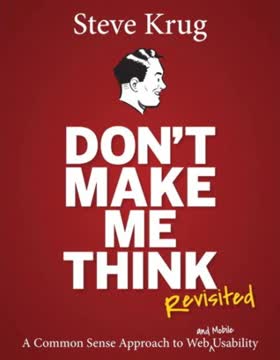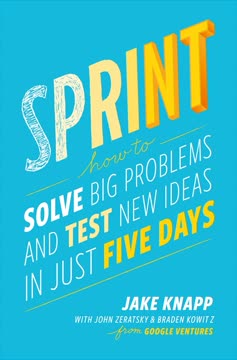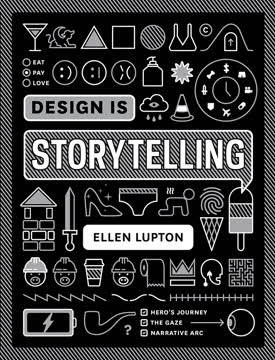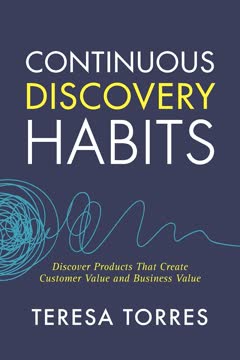Key Takeaways
1. Identify the Mess: Recognize Information and People as Key Components
Information is not a thing. It's subjective, not objective. It's whatever a user interprets from the arrangement or sequence of things they encounter.
Information is interpretive. It's not just data or content, but how users understand and perceive what they encounter. This subjective nature means that the same arrangement can lead to different interpretations based on individual experiences and contexts.
People are complex. Users and stakeholders bring their own contradictions, behaviors, and expectations to any situation. Understanding this complexity is crucial for effective information architecture. Consider:
- User expectations (e.g., digital vs. physical, automation vs. human touch)
- Stakeholder perspectives and interests
- The impact of personal preferences and opinions
2. State Your Intent: Use Language to Define Goals and Direction
The words we choose matter. They represent the ideas we want to bring into the world.
Language shapes intent. The words you use to describe your goals and direction have a profound impact on the outcome. They influence:
- What you create vs. what you don't
- How users perceive and interact with your product or service
- The methods and approaches you'll use to achieve your goals
Balance looking good and being good. While aesthetics are important, they shouldn't overshadow functionality and usefulness. Consider:
- How your choices reflect your intent
- The need for clarity in communicating your message
- The balance between beauty and quality of thought
3. Face Reality: Confront the Complexities of Users, Stakeholders, and Context
By facing reality, we can find solutions.
Embrace complexity. Acknowledging the multi-faceted nature of your situation is the first step towards finding effective solutions. This involves:
- Recognizing fears and potential obstacles
- Understanding the various players involved (users, stakeholders, competitors)
- Considering multiple factors (time, resources, skills, environment, politics, ethics)
Map out the landscape. Use visual tools to better understand and communicate the complexities you're dealing with:
- Create diagrams and maps to represent relationships and structures
- Consider channels and contexts where users interact with your product or service
- Use these visual representations to facilitate discussions and gain insights
4. Choose a Direction: Establish Clear Language and Priorities
Language is the material of intent.
Define your vocabulary. Creating a shared language is crucial for effective communication and decision-making. This involves:
- Developing a controlled vocabulary of key terms and concepts
- Clarifying ambiguous terms and potential misunderstandings
- Documenting the history, alternatives, and myths associated with important terms
Set priorities. With a clear language established, focus on determining the most important aspects of your project:
- Identify key nouns (objects, people, places) and verbs (actions) related to your work
- Create a list of requirements that combine these nouns and verbs
- Prioritize these requirements based on your goals and user needs
5. Measure the Distance: Set Goals and Track Progress with Indicators
Progress is as important to measure as success.
Establish clear goals. Break down your overall intent into specific, measurable objectives. For each goal, consider:
- Intent: What specific results do you want to see?
- Baseline: What's the current state you're measuring against?
- Progress: How will you track movement towards or away from the goal?
Choose relevant indicators. Select metrics that genuinely reflect progress towards your goals. Common indicators include:
- Satisfaction, loyalty, and perception metrics
- Traffic, conversion, and engagement metrics
- Financial metrics (profit, expenses, value)
- Efficiency metrics (time saved, waste reduction)
Set up a measurement system. Create a process for regularly tracking and reviewing your chosen indicators:
- Determine appropriate measurement rhythms (daily, weekly, monthly, etc.)
- Establish flags or alerts for significant changes
- Use worksheets or other tools to collect data from stakeholders and users
6. Play with Structure: Explore Various Taxonomies and Classifications
There are many ways to structure things.
Understand taxonomies. Taxonomies are the methods we use to organize and classify information. Key concepts include:
- Hierarchical vs. heterarchical structures
- Sequential arrangements
- Use of hypertext to connect disparate elements
Consider facets and classification. Think about the various ways your content can be organized:
- Identify relevant facets (discrete pieces of knowledge for classification)
- Balance exact and ambiguous classifications based on your context
- Consider how your classification choices reflect your intent and audience
Experiment with structures. Don't settle for the first arrangement you create:
- Try multiple approaches (hierarchies, sequences, networks)
- Use simple tools like boxes and arrows to quickly iterate
- Test your structures with users and stakeholders for feedback
7. Prepare to Adjust: Embrace Collaboration and Continuous Refinement
Adjustments are a part of reality.
Collaboration is key. Involving stakeholders and users throughout the process leads to better outcomes:
- Share your work early and often
- Facilitate discussions to address tensions and misunderstandings
- Be open to feedback and willing to make changes
Maintain flexibility. Recognize that your work will evolve as you gain new insights:
- Don't seek finalization; embrace ongoing refinement
- Be prepared to adjust your course as new information becomes available
- Focus on progress rather than perfection
Remember the bigger picture. While details are important, always consider how individual elements contribute to the whole:
- Regularly step back to assess the overall user experience
- Consider how changes in one area might affect others
- Strive for consistency and coherence across all aspects of your work
Last updated:
FAQ
What's "How to Make Sense of Any Mess" about?
- Purpose: The book is a guide to understanding and organizing complex information and situations, referred to as "messes."
- Audience: It is designed for anyone who deals with information, including students, designers, business owners, and executives.
- Approach: Abby Covert provides a step-by-step process to help readers make sense of messes, using information architecture principles.
- Structure: The book includes chapters, worksheets, and a lexicon to aid in understanding and applying the concepts.
Why should I read "How to Make Sense of Any Mess"?
- Practical Guidance: It offers practical tools and methods to tackle information-related challenges in various contexts.
- Broad Applicability: The concepts are applicable to a wide range of fields, from design to business management.
- Empowerment: The book empowers readers to take control of chaotic situations by providing a clear framework for action.
- Skill Development: It helps develop skills in information architecture, which are valuable in today's information-rich world.
What are the key takeaways of "How to Make Sense of Any Mess"?
- Identify the Mess: Recognize and define the boundaries of the mess you are dealing with.
- State Your Intent: Clearly articulate what you want to achieve and why.
- Face Reality: Understand the current state of affairs, including constraints and opportunities.
- Choose a Direction: Decide on a path forward based on your goals and the reality you face.
What is information architecture according to Abby Covert?
- Definition: Information architecture is the way we arrange the parts of something to make it understandable.
- Examples: It includes systems like alphabetical cross-referencing, website navigation, and menu organization.
- Purpose: The goal is to help people make sense of the world by organizing information effectively.
- Responsibility: Everyone shares the responsibility of architecting information, whether they realize it or not.
How does Abby Covert suggest identifying a mess?
- Definition of Mess: A mess is any situation where something is confusing or full of difficulty.
- Common Messes: These include organizational structures, communication methods, and product representations.
- First Step: Shine a light on the mess to outline its edges and depths.
- Guidance: Use the book's worksheets and questions to start identifying the mess you're facing.
What is the role of intent in making sense of a mess?
- Intent as Language: Intent is the effect you want to have, and it is expressed through language.
- Defining Good: Clearly define what "good" means for your stakeholders and users.
- Language Choices: The words you choose can change how you use time and energy.
- Alignment: Ensure that your intent aligns with the language and actions you take.
How does "How to Make Sense of Any Mess" address facing reality?
- Reality Check: Acknowledge the current state, including players, factors, and contexts.
- Complexity: Understand that reality involves many players and factors that can complicate the mess.
- Diagrammatic Techniques: Use diagrams and maps to document and understand the details of your reality.
- Collaboration: Engage with stakeholders and users to gain a clearer understanding of the mess.
What are some common diagrams and maps used in information architecture?
- Block Diagram: Depicts how objects and their attributes interrelate to create a concept.
- Flow Diagram: Outlines the steps in a process, including conditions and connections.
- Gantt Chart: Shows how processes relate to one another over time.
- Mind Map: Illustrates connections between concepts, ideas, and people within a context.
How does Abby Covert suggest choosing a direction?
- Levels of Work: Understand the levels you're working at, from objects to ecosystems.
- Placemaking: Arrange spaces to communicate their intended use to users.
- Language Matters: Define and agree on the language used to describe your direction.
- Controlled Vocabulary: Create a list of terms to ensure clear communication.
What are the best quotes from "How to Make Sense of Any Mess" and what do they mean?
- Carl Sagan Quote: "If you wish to make an apple pie from scratch, you must first invent the universe." This highlights the complexity and interconnectedness of creating something new.
- Information as Responsibility: "Information is a responsibility we all share." This emphasizes the shared duty of organizing and communicating information effectively.
- Complexity of Knowledge: "Knowledge is surprisingly subjective." This points to the idea that understanding and truth can vary between individuals.
How does "How to Make Sense of Any Mess" suggest measuring progress?
- Goals and Baselines: Break intent into specific goals and establish baselines for comparison.
- Indicators: Use indicators like satisfaction, profit, and traffic to measure progress.
- Flags: Set up flags to alert you to important changes or milestones.
- Rhythm of Measurement: Choose the right rhythm for measuring progress based on context and intent.
How does Abby Covert recommend preparing to adjust?
- Embrace Change: Accept that adjustments are a part of reality and necessary for progress.
- Collaboration: Work with stakeholders and users to refine and improve your approach.
- Feedback: Use feedback to continuously refine your structures and methods.
- Avoid Perfectionism: Focus on progress rather than perfection, as messes grow with time.
Review Summary
How to Make Sense of Any Mess receives mixed reviews, with an overall rating of 3.85/5. Readers appreciate its concise introduction to information architecture, praising its simplicity and accessibility. Some find it valuable for beginners and a good refresher for experienced professionals. Critics argue it lacks depth and concrete examples, making it too general for practical application. The book's format of short, one-page lessons is both praised for its readability and criticized for its lack of substance. Many readers recommend it as a starting point for understanding information architecture concepts.
Similar Books










Download PDF
Download EPUB
.epub digital book format is ideal for reading ebooks on phones, tablets, and e-readers.




